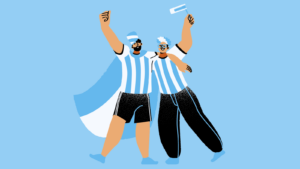Our disrupted world is poised for more disruption. New technologies have already upended many industries and professions. English language teaching and education more generally have not been an exception. Language learning apps, chatbots, automatic translation apps — already technology has displaced many of the traditional roles of language teachers (and students). The trend toward MOOCs (Massive Open Online Courses) also means that fewer “superstar” teachers can teach more and more students. In the near future, it is easy to imagine Artificial Intelligence (AI) penetrating every part of the curriculum, targeting weaknesses and providing meaningful tasks in ways that human teachers could only dream of.
These trends have been explored in depth by authors such as Richard Baldwin and Yuval Noah Harari. As both authors point out, AI will disrupt many sectors of the economy, including white-collar jobs that many once thought secure. It is important to note some scholars believe that the current discourse around AI is inflated by hype and an underreporting of AI failures (see this insightful article by Martin Ciupa for more). However, if one imagines even modest improvements year after year in educational technologies (or even a better integration of existing technologies), it is not hard to imagine that the role of teachers could change dramatically.
What role, then, can teachers and especially English language teachers hope to fill?
One possible and perhaps very obvious answer: language teachers will learn to embrace the “liberal arts.”
What are the liberal arts? In short, it is an approach to education that forces students to read broadly, think deeply and explore the world’s most difficult problems. One may think of it as the opposite of a focused technical education. (For more definitions, see an article by Scott Hartley in Diplomatic Courier, paragraph 3; and this interview with Fareed Zakaria in Forbes, paragraph 6; for wonderful essays in the spirit of liberal arts, read more here).
But perhaps the best way to understand liberal education is in terms of liberty. Liberal arts seeks to liberate people from ignorance and thus, unlock the full potential of each human being.
In a disrupted world, an approach to education that emphasizes a broad foundation for critical thinking and exploration seems to hold great promise. And yet, in the information age, liberal education continues to have its detractors. Sceptics note that the soft skills of a liberal education are hard to quantify and may stunt career training that leads to an early job (for more, read here or here.)
Despite these very valid concerns, a liberal education seems to offer a role for education that goes beyond mere economic utility. With small class sizes, an emphasis on a shared learning community and self-exploration, liberal education offers freedom of a broader kind: the freedom to be the best version of oneself.
This short article will explore the potential of a liberal arts approach in the 21st century.
The liberal arts make sense because passive forms of learning can be automated.
First, a trend toward liberal arts makes sense because even now passive forms of education are being automated. Many textbooks have automated the study and grading of listening, reading, vocabulary and grammar activities and the trend toward the automation of language learning will continue as applications continue to develop.
Duolingo, Quizlet, Memrise, and WordEngine, to name only a few, are applications that offer cheap or free language learning experiences. As writing applications such as Grammarly and Trinka develop, they will also relieve writing teachers of the more onerous tasks of error correction. Xreading and Extensive Reading Central have already automated extensive reading activities and the chat application Replika allows students to chat with an AI, replicating a real-time conversation partner (though sometimes badly).
Just as in other sectors of the economy where basic functions are being automated, it is easy to see these new technologies as a threat. However, automation also makes it possible for teachers to focus on skills that are especially human and value-added, making classroom time more rewarding for both teachers and students.
A liberal arts education is uniquely positioned to nurture human skills.
The most obvious insight for those looking to the future of teaching would be to note that, in comparison to automated and AI-enhanced learning tools, humans still maintain an advantage in the skills that make human-to-human relationships possible.
Even as I write this, however, I realize that this answer might end up being too glib. In a world where computers have access to vast amounts of personal data, algorithmic-enabled programs could easily outmatch teachers in forming intimate bonds with students. As I write these words, I fear that I am already far less popular with my students than their phones. Future generations of students might have a level of intimacy with their technology that dwarfs anything we have yet seen.
And yet, at least in the short term, it is these “soft” human skills where teachers will have the advantage. Teachers can still excel in imparting the human qualities of empathy, adaptability, conscientiousness, perseverance and creativity. Indeed, because of the advantage future technologies will have in leveraging data to forge relationships with students, it will be an imperative in the short-term for teachers to pass on these human skills and to sanctify them through meaningful classroom experiences.
A liberal arts education — an approach that emphasizes the human experience in the broadest possible terms — is perhaps the best way to impart these values in the classroom.
The liberal arts can help students tackle economic uncertainty.
If teachers are insecure in this new economy, then so are students. At this moment, no worker can be sure of what will happen to their company, the value of their skill set, or even the value of humans within an evolving world economy. Again, these concepts have been explored in depth by Yuval Noah Harari and Richard Baldwin. Their books are exactly the kind of reading that would be assigned in a liberal arts class on the 21st-century economy.
Liberal arts is the best tool to take on an uncertain economy because it takes a broad view of everything, including the uniqueness of a “disrupted economy.” Is this the first time workers have faced radical uncertainty or even obsolescence? As Richard Baldwin has explored in his own research, humans have faced one upheaval after another. From the first Industrial Revolution to the present, workers have been disrupted by steam power, coal, the advent of new tools and the creation of new machines. This has led to a cycle of upheaval, backlash and resolution. There is comfort in knowing that there is a rich tradition of struggling against technological upheaval. A liberal arts approach to education brings students into contact with this rich history and helps shine a light on new backlashes and possible resolutions.
The liberal arts also encourages students to look at speculative fiction. Is the 21st century really that shocking to someone who has read Stephen Neal’s Snow Crash? (See the author’s essay on the topic.)
Education can be more meaningful through project-based education and “skin in the game.”
As technology evolves, so will human needs. Though it is impossible to predict the problems of tomorrow, liberal arts education builds the best foundation for finding and solving these problems. Increasingly, class assignments can be designed as projects in entrepreneurship (in the broadest sense of the word), where students find problems out there in the world and design projects to solve them.
The skill of “need-finding” is one frequently taught in entrepreneurship classes. “Needs,” can be taught in the broadest sense of the word and can also include social injustices. As Tina Seelig preaches in her writing and classes on entrepreneurship, “The bigger the problem, the bigger the opportunity.”
Because the liberal arts emphasizes small classroom sizes and critical thinking, classes can become mini-think tanks directed at leveraging collective expertise to solve problems as they arise. Rather than stale, riskless enterprises, classrooms can be places where students and teachers alike put their “skin in the game” (for more on these concepts, see Nicholas Nassim Taleb and Steve Jobs) and learn through doing.
Liberal education can serve as a moral enterprise and inoculation against tyranny.
Liberal education should also serve as a corrective to engineers and entrepreneurs who push the technological envelope without contemplating the deeper meaning and purpose of progress and technology.
Those all-important human questions: What is all this technology for, in the end? What are the unintended consequences of technology and development? How can modernity be made more humane and inclusive?
One of the dangers of a narrow curriculum that focuses on business or technical competence — for example, the MBA or even the more narrow professional certificate programs on sites like Coursera or EdX — is that they may breed a class of highly competent but morally hollow citizens.
Business acumen, technological skills and other trade skills may benefit a person’s livelihood in the short term. Yet, society as a whole may be worse off if these highly-skilled individuals are insensitive to the second, third, fourth, and N-th order effects of their inventions and actions.
A more cynical author might write that the problems of our time — populist rage, political extremism, economic instability and insecurity, social media addiction — are the externalities of a technically and administratively brilliant but otherwise morally hollow elite. I have not yet reached that level of cynicism (…yet), but I will note — without any empirical evidence to support my claim other than my own isolated experiences — that increasingly school and workplaces tend to value “competence” over the more classical virtue of “character” and that frequently “competence” and “winning” are conflated and confused with “character” and “virtue.” In all of the settings where I have witnessed this trend, I have felt that everyone is left impoverished.
Would a CEO steeped in the humanities allow their product or platform to be the breeding ground of conspiracy theories and racist propaganda?
This is the kind of question that can and should be debated in a 21st- century classroom.
As the attractive power of medicine and technology grow, so too must our capacity for critical thinking, humility, empathy, and compassion. A broad education that includes time well-spent in the humanities is an important corrective.
We need better liberal arts for the 21st century.
In a century where there are no easy answers to technological disruption, an approach that rejects easy answers seems like an auspicious path. However, Ii the liberal arts is an answer to the question of twenty-first century problems, it is an incomplete one.
The liberal arts too must be innovated.
For a liberal arts approach to truly prove its worth in the 21st-century, I believe it must do the following:
- Develop an understanding of what human values it wishes to protect from technological disruption.
- Leverage the resources of the school and the classroom to make real improvements to the world outside the classroom.
- Encourage the wise use of risk or “skin in the game” for classroom projects.
- Understand how to build effective problem-solving communities.
These are only my tentative answers to the question of how to improve the liberal arts. It is a beginning, not an end.
Unlocking Infinity.
Finally, a liberal arts approach must work from a realization that there is no upward limit to human growth. (For more on this idea, please see David Deutsch’s The Beginning of Infinity.) In all our educational pursuits, what we are really trying to do is unlock the infinite potential of the learner.
If this goal sounds vague and unrealistic, then know that it could only have come from the pen of a student of the liberal arts.
Hopefully you have an idea about the future of English language teaching.




